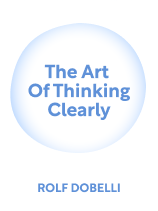

This article is an excerpt from the Shortform book guide to "The Art of Thinking Clearly" by Rolf Dobelli. Shortform has the world's best summaries and analyses of books you should be reading.
Like this article? Sign up for a free trial here .
What is the psychology behind reciprocity? Why do we feel the need to reciprocate benevolent behavior?
In social psychology, reciprocity is the tendency to return a favor or a benevolent action with another benevolent action. According to Rolf Dobelli, the author of The Art of Thinking Clearly, this phenomenon is a by-product of the human need to belong to a group.
Keep reading to learn about the phenomenon of reciprocity, why it occurs, and how it’s used as a tool for manipulation.
The Psychology of Reciprocity
In social psychology, reciprocity is a tendency that forms out of humanity’s instinctual desire to be part of a group: If someone does something for you, you’re more likely to do something for them in return. This comes from a dislike of being in other people’s debt.
(Shortform note: How specifically you react to being in someone’s debt depends on your reciprocity style: You either only help others when it benefits you, and so are less affected by being in debt; help others for the sake of helping even when it means a loss for yourself, and so are highly affected by being in debt; or help others to the same extent they help you, where you have a more neutral reaction to being in debt.)
Reciprocity is a vital part of life, Dobelli notes. It inspires cooperation, creates and strengthens communities, and helps keep the group healthy. (Shortform note: Mutual aid is a form of reciprocity that inspires these factors. Communities unite to support the group, everyone helping and being helped in turn. Poor and marginalized groups have used mutual aid throughout history, and researchers have even observed the phenomenon in animals, pointing to reciprocity’s evolutionary origins.)
Unfortunately, Dobelli concedes, this tendency can be twisted. Manipulating people into giving you something is easy if you first make them feel indebted to you. (Shortform note: Often, manipulative people offer you some small benefit before asking for a larger favor. Even though the exchange is imbalanced, you still feel compelled to agree.)
Reciprocity also has a dark side: retaliation. Dobelli points out that when others are kind to you, you want to return the favor and be nice as well, but if someone hurts you, you want to hurt them in return. This cycle only escalates the problem.
(Shortform note: Though Dobelli argues that retaliation is dangerous, others argue that retaliation—or negative reciprocity—is a necessary part of cooperation. They clarify that Dobelli refers to private retaliation, where an injured party carries out retaliation without supervision and frequently over-retaliates, prompting the initial aggressor to retaliate in turn. However, public retaliation is the basis of the legal system: A proportionate form of retaliation is objectively determined and taken against the initial aggressor. Given this definition, retaliation is an important part of society, so long as it’s objectively proportionate.)

———End of Preview———
Like what you just read? Read the rest of the world's best book summary and analysis of Rolf Dobelli's "The Art of Thinking Clearly" at Shortform .
Here's what you'll find in our full The Art of Thinking Clearly summary :
- A detailed look at the most common logical fallacies that inhibit decision-making
- How to recognize and overcome these fallacies to make better decisions
- Why you value things for arbitrary reasons






